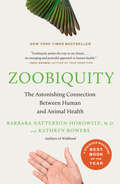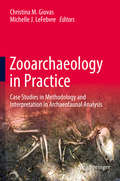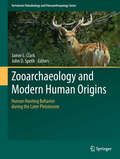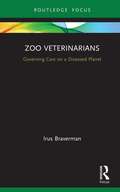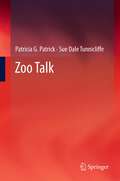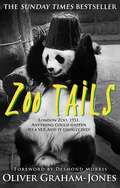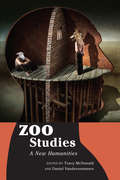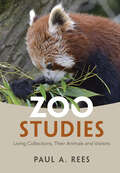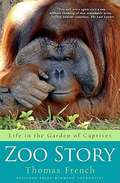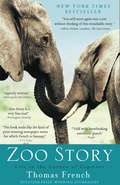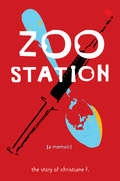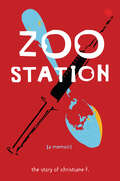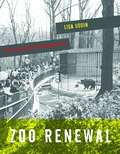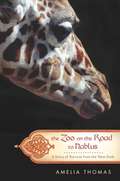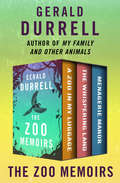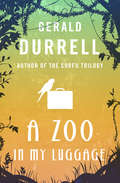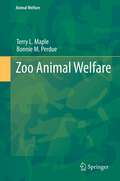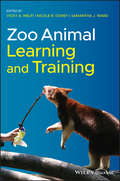- Table View
- List View
Zoobiquity: What Animals Can Teach Us About Health and the Science of Healing
by Kathryn Bowers Barbara Natterson-HorowitzIn the spring of 2005, cardiologist Barbara Natterson-Horowitz was called to consult on an unusual patient: an Emperor tamarin at the Los Angeles Zoo. While examining the tiny monkey's sick heart, she learned that wild animals can die of a form of cardiac arrest brought on by extreme emotional stress. It was a syndrome identical to a human condition but one that veterinarians called by a different name--and treated in innovative ways. This remarkable medical parallel launched Natterson-Horowitz on a journey of discovery that reshaped her entire approach to medicine. She began to search for other connections between the human and animal worlds: Do animals get breast cancer, anxiety-induced fainting spells, sexually transmitted diseases? Do they suffer from obsessive-compulsive disorder, bulimia, addiction? The answers were astonishing. Dinosaurs suffered from brain cancer. Koalas catch chlamydia. Reindeer seek narcotic escape in hallucinogenic mushrooms. Stallions self-mutilate. Gorillas experience clinical depression. Joining forces with science journalist Kathryn Bowers, Natterson-Horowitz employs fascinating case studies and meticulous scholarship to present a revelatory understanding of what animals can teach us about the human body and mind. "Zoobiquity" is the term the authors have coined to refer to a new, species-spanning approach to health. Delving into evolution, anthropology, sociology, biology, veterinary science, and zoology, they break down the walls between disciplines, redefining the boundaries of medicine. Zoobiquity explores how animal and human commonality can be used to diagnose, treat, and heal patients of all species. Both authoritative and accessible, offering cutting-edge research through captivating narratives, this provocative book encourages us to see our essential connection to all living beings.
Zooarchaeology in Practice
by Christina M. Giovas Michelle J. LeFebvreZooarchaeology in Practice advances the methodological discussion beyond its present strictures by addressing the development of analytically sound practices through a collection of seminal essays authored by leading figures in the field. Offering a level of depth and breadth not readily found in the available literature, this volume examines how zooarchaeological data and interpretation are shaped by its method of practice, exploring the impact of these effects at all levels of zooarchaeological investigation. Employing a geographically and taxonomically diverse set of case studies, contributing authors provide instructive approaches to problems in traditional and emerging areas of methodological concern. Readers, from specialists to students, will gain an extensive, sophisticated look at important disciplinary issues, sure to provoke critical reflection on the nature and importance of sound methodology. With implications for how archaeologists reconstruct human behavior and paleoecology, and broader relevance to fields such as paleontology and conservation biology, Zooarchaeology in Practice makes an enduring contribution to the methodological advancement of the discipline.
Zooarchaeology and Modern Human Origins: Human Hunting Behavior during the Later Pleistocene
by Jamie L. Clark John D. SpethRecent genetic data showing that Neanderthals interbred with modern humans have made it clear that deeper insight into the behavioral differences between these populations will be critical to understanding the rapid spread of modern humans and the demise of the Neanderthals. This volume, which brings together scholars who have worked with faunal assemblages from Europe, the Near East, and Africa, makes an important contribution to our broader understanding of Neanderthal extinction and modern human origins through its focus on variability in human hunting behavior between 70-25,000 years ago--a critical period in the later evolution of our species.
Zooarchaeology
by Elizabeth J. Reitz Elizabeth S. WingThis book includes new sections on enamel ultra structure and incremental analysis, stable isotopes and trace elements, ancient genetics and enzymes, environmental reconstruction, people as agents of environmental change etc.
Zoo Veterinarians: Governing Care on a Diseased Planet (Law, Science and Society)
by Irus BravermanDespite their centrality to the operation of contemporary accredited zoo and aquarium institutions, the work of zoo veterinarians has rarely, if ever, been the focus of a critical analysis in the social science and humanities. Drawing on in-depth interviews and observations of zoo and aquarium veterinarians in Europe and North America, this book highlights the recent transformation that has occurred in the zoo veterinarian profession during a time of ecological crisis, and what these changes can teach us about our rapidly changing planet. Zoo vets, Braverman instructs us with a wink, have "gone wild." Originally an individual welfare-centered profession, these experts are increasingly concerned with the sustainability of wild animal populations and with ecological health. In this sense, the story of zoo vets "going wild"—in their subjects of care, their motivations, and their ethical standards, as well as in their professional practices and scientific techniques—is also a story about zoo animals gone wild, wild animals encroaching the zoo, and, more generally, a wild world that is becoming "zoo-ified." Such transformations have challenged existing norms of veterinary practice. Exploring the regulatory landscape that governs the work of zoo and aquarium veterinarians, Braverman traverses the gap between the hard and soft sciences and between humans and nonhumans. At the intersection of animal studies, socio-legal studies, and Science and Technology Studies, this book will appeal not only to those interested in zoos and in animal welfare, but also to scholars in the posthumanities.
Zoo Vet: Adventures of A Wild Animal Doctor
by David TaylorIn this book, Taylor shares some of his experiences as he cares for exotic animals. Not all stories have happy endings, but all are heart-warming. This is an honest look at what it was like to be a zoo vet in the fifties and sixties.
Zoo Talk
by Sue Dale Tunnicliffe Patricia G. PatrickFounded on the premise that zoos are 'bilingual'--that the zoo, in the shape of its staff and exhibits, and its visitors speak distinct languages--this enlightening analysis of the informal learning that occurs in zoos examines the 'speech' of exhibits and staff as well as the discourse of visitors beginning in the earliest years. Using real-life conversations among visitors as a basis for discussion, the authors interrogate children's responses to the exhibits and by doing so develop an 'informal learning model' and a 'zoo knowledge model' that prompts suggestions for activities that classroom educators can use before, during, and after a zoo visit. Their analysis of the 'visitor voice' informs creative suggestions for how to enhance the educational experiences of young patrons. By assessing visitors' entry knowledge and their interpretations of the exhibits, the authors establish a baseline for zoos that helps them to refine their communication with visitors, for example in expanding knowledge of issues concerning biodiversity and biological conservation. The book includes practical advice for zoo and classroom educators about positive ways to prepare for zoo visits, engaging activities during visits, and follow-up work that maximizes the pedagogical benefits. It also reflects on the interplay between the developing role of zoos as facilitators of learning, and the ways in which zoos help visitors assimilate the knowledge on offer. In addition to being essential reading for educators in zoos and in the classroom, this volume is full of insights with much broader contextual relevance for getting the most out of museum visits and field trips in general.
Zoo Tails
by Oliver Graham JonesOne puff adder, one antelope, one crocodile – This was the list of sick animals presented to Oliver Graham-Jones on his first day as a new vet at London Zoo in 1951. And his time at the zoo didn’t get any less strange or entertaining…There’s the time he anaesthetized, and was then chased by, a gorilla; had to capture an angry polar bear in thick fog; performed a colostomy on a python; and fitted a raven in the Tower of London with a wooden leg. And if an animal escaped (more frequently than you might think) or required urgent medical attention, he was always on hand, ready for any eventuality. With his self-deprecating humour, Oliver frequently described himself as quaking with fear, but he was also skilful, brave and, most of all, incredibly caring and kind to his animal patients.
Zoo Studies: A New Humanities
by Tracy McDonald Daniel VandersommersDo both the zoo and the mental hospital induce psychosis, as humans are treated as animals and animals are treated as humans? How have we looked at animals in the past, and how do we look at them today? How have zoos presented themselves, and their purpose, over time? In response to the emergence of environmental and animal studies, anthropologists, sociologists, philosophers, theorists, literature scholars, and historians around the world have begun to explore the significance of zoological parks, past and present. <P><P> Zoo Studies considers the modern zoo from a range of approaches and disciplines, united in a desire to blur the boundaries between human and nonhuman animals. The volume begins with an account of the first modern mental hospital, La Salpêtrière, established in 1656, and the first panoptical zoo, the menagerie at Versailles, created in 1662 by the same royal architect; the final chapter presents a choreographic performance that imagines the Toronto Zoo as a place where the human body can be inspired by animal bodies. From beginning to end, through interdisciplinary collaboration, this volume decentres the human subject and offers alternative ways of thinking about zoos and their inhabitants. This collection immerses readers in the lives of animals and their experiences of captivity and asks us to reflect on our own assumptions about both humans and animals. <P><P> An original and groundbreaking work, Zoo Studies will change the way readers see nonhuman animals and themselves.
Zoo Studies: Living Collections, Their Animals and Visitors
by Paul A. ReesZoos and aquariums are culturally and historically important places where families enjoy their leisure time and scientists study exotic animals. Many contain buildings of great architectural merit. Some people consider zoos little more than animal prisons, while others believe they play an important role in conservation and education. Zoos have been the subject of a vast number of academic studies, whose results are scattered throughout the literature. This interdisciplinary volume brings together research on animal behaviour, visitor studies, zoo history, human-animal relationships, veterinary medicine, welfare, education, enclosure design, reproduction, legislation, and zoo management conducted at around 200 institutions located throughout the world. The book is neither 'pro-' nor 'anti-' zoo and attempts to strike a balance between praising zoos for the good work they have done in the conservation of some species, while recognising that they face many challenges in making themselves relevant in the modern world.
Zoo Studies: A New Humanities
by Tracy McDonald and Daniel VandersommersDo both the zoo and the mental hospital induce psychosis, as humans are treated as animals and animals are treated as humans? How have we looked at animals in the past, and how do we look at them today? How have zoos presented themselves, and their purpose, over time? In response to the emergence of environmental and animal studies, anthropologists, sociologists, philosophers, theorists, literature scholars, and historians around the world have begun to explore the significance of zoological parks, past and present. Zoo Studies considers the modern zoo from a range of approaches and disciplines, united in a desire to blur the boundaries between human and nonhuman animals. The volume begins with an account of the first modern mental hospital, La Salpêtrière, established in 1656, and the first panoptical zoo, the menagerie at Versailles, created in 1662 by the same royal architect; the final chapter presents a choreographic performance that imagines the Toronto Zoo as a place where the human body can be inspired by animal bodies. From beginning to end, through interdisciplinary collaboration, this volume decentres the human subject and offers alternative ways of thinking about zoos and their inhabitants. This collection immerses readers in the lives of animals and their experiences of captivity and asks us to reflect on our own assumptions about both humans and animals. An original and groundbreaking work, Zoo Studies will change the way readers see nonhuman animals and themselves.
Zoo Story: Life in the Garden of Captives
by Thomas French"Animals Make Us Human" meets "An Inconvenient Truth" as a Pulitzer Prize-winning journalist goes behind the scenes at one of the country's most popular--and most controversial--destinations: a zoo. This meticulously reported and smartly written book will make you think in new ways about animals, human beings, and our respective places in the world. But far from being an "issues" book, "Zoo Story" describes a time of profound drama at Lowry Park Zoo in Tampa, the site of shocking and tragic events while author Tom French was there. This an unforgettable read, and every word is true.
Zoo Story: Life in the Garden of Captives
by Thomas French"This story, told by a master teller of such things, does more than take you inside the cages, fences, and walls of a zoo. It takes you inside the human heart, and an elephant's, and a primate's, and on and on. Tom French did in this book what he always does. He took real life and wrote it down for us, with eloquence and feeling and aching detail."-Rick Bragg, Pulitzer Prize-winning journalist and bestselling author"An insightful and detailed look at the complex life of a zoo and its denizens, both animal and human."-Yann Martel, author of Life of Pi and Beatrice and VirgilWelcome to the savage and surprising world of Zoo Story, an unprecedented account of the secret life of a zoo and its inhabitants. Based on six years of research, the book follows a handful of unforgettable characters at Tampa's Lowry Park Zoo: an alpha chimp with a weakness for blondes, a ferocious tiger who revels in Obsession perfume, and a brilliant but tyrannical CEO known as El Diablo Blanco. The sweeping narrative takes the reader from the African savannah to the forests of Panama and deep into the inner workings of a place some describe as a sanctuary and others condemn as a prison. Zoo Story shows us how these remarkable individuals live, how some die, and what their experiences reveal about the human desire to both exalt and control nature.
Zoo Station
by Christina Cartwright Christiane FIn 1978 Christiane F. testified against a man who had traded heroin for sex with teenage girls at Berlin's notorious Zoo Station. In the course of that trial, Christiane F. became connected with two journalists, and over time they helped to turn her story--which begins with a dysfunctional but otherwise fairly normal childhood--into an acclaimed bestseller. Christiane F.'s rapid descent into heroin abuse and prostitution is shocking, but the boredom, the longing for acceptance, the thrilling risks, and even the musical obsessions that fill out the rest of Christiane's existence will be familiar to every reader. Christiane F.'s Berlin is a strange and often terrifying place, but it's also a place that remains closer than we might think....
Zoo Station: The Story of Christiane F.
by Christina Cartwright Christiane F.In 1978 Christiane F. testified against a man who had traded heroin for sex with teenage girls at Berlin's notorious Zoo Station. In the course of that trial, Christiane F. became connected with two journalists, and over time they helped to turn her story--which begins with a dysfunctional but otherwise fairly normal childhood--into an acclaimed bestseller. Christiane F.'s rapid descent into heroin abuse and prostitution is shocking, but the boredom, the longing for acceptance, the thrilling risks, and even the musical obsessions that fill out the rest of Christiane's existence will be familiar to every reader. Christiane F.'s Berlin is a strange and often terrifying place, but it's also a place that remains closer than we might think....
Zoo Station: The Story of Christiane F.
by Christiane F.This incredible autobiography of Christiane F. provides a vivid portrait of teen friendship, drug abuse, and alienation in and around Berlin's notorious Zoo Station. Christiane's rapid descent into heroin abuse and prostitution is shocking, but the boredom, longing for acceptance, thrilling risks, and even her musical obsessions are familiar to everyone. Previously published in Germany and the US to critical acclaim, Zest's new translation includes original photographs of Christiane and her friends.
Zoo Station
by Christiane F Christina CartwrightIn 1978 Christiane F. testified against a man who had traded heroin for sex with teenage girls at Berlin's notorious Zoo Station. In the course of that trial, Christiane F. became connected with two journalists, and over time they helped to turn her story--which begins with a dysfunctional but otherwise fairly normal childhood--into an acclaimed bestseller. Christiane F.'s rapid descent into heroin abuse and prostitution is shocking, but the boredom, the longing for acceptance, the thrilling risks, and even the musical obsessions that fill out the rest of Christiane's existence will be familiar to every reader. Christiane F.'s Berlin is a strange and often terrifying place, but it's also a place that remains closer than we might think....
Zoo Renewal
by Lisa UddinWhy do we feel bad at the zoo? In a fascinating counterhistory of American zoos in the 1960s and 1970s, Lisa Uddin revisits the familiar narrative of zoo reform, from naked cages to more naturalistic enclosures. She argues that reform belongs to the story of cities and feelings toward many of their human inhabitants. In Zoo Renewal, Uddin demonstrates how efforts to make the zoo more natural and a haven for particular species reflected white fears about the American city--and, pointedly, how the shame many visitors felt in observing confined animals drew on broader anxieties about race and urban life. Examining the campaign against cages, renovations at the National Zoo in Washington, D.C. and the San Diego Zoo, and the cases of a rare female white Bengal tiger and a collection of southern white rhinoceroses, Uddin unpacks episodes that challenge assumptions that zoos are about other worlds and other creatures and expand the history of U.S. urbanism. Uddin shows how the drive to protect endangered species and to ensure larger, safer zoos was shaped by struggles over urban decay, suburban growth, and the dilemmas of postwar American whiteness. In so doing, Zoo Renewal ultimately reveals how feeling bad, or good, at the zoo is connected to our feelings about American cities and their residents.
The Zoo on the Road to Nablus: A Story of Survival from the West Bank
by Amelia ThomasThe last Palestinian zoo stands on a dusty, dead-end street in the once prosperous farming town of Qalqilya, on the very edge of the West Bank. The zoo's bars are rusting; peacocks wander quiet avenues shaded by broad plane trees; a teenage baboon broods in solitary confinement; walls bear the pockmarks of gunfire. And yet the zoo is an extraordinary place, with a bizarre, troubling and inspiring story to tell. At the center of this story is Dr. Sami Khader, the only zoo veterinarian in the Palestinian territories. Family man, amateur inventor, and dedicated taxidermist, he is fiercely independent, apolitical, and resourceful in times of crisis. Dr. Sami dreams of transforming the zoo into one of an international caliber. In The Zoo on the Road to Nablus, Amelia Thomas brings the reader into a world rarely glimpsed from the outside, weaving the stories of the zoo's animals, its staff, and its visitors into a rich, colorful chronicle of the indomitability of the human-and animal-spirit.
The Zoo Memoirs: A Zoo in My Luggage, The Whispering Land, and Menagerie Manor (The Zoo Memoirs #3)
by Gerald DurrellThe British naturalist and bestselling author of the Corfu Trilogy—the inspiration for the Masterpiece production The Durrells in Corfu—founds a zoo. In this trio of delightful memoirs, British wildlife preservation pioneer and national bestselling author Gerald Durrell recounts the ups and downs he faces in transforming his lifelong dream of creating a new kind of zoo into a reality. A Zoo in My Luggage: In 1957, Durrell and his wife travel to the British Cameroons in West Africa to begin assembling his menagerie. The greater challenge proves to be in safely transporting their exotic animals back to Britain and finding a home for them. “Animals come close to being Durrell’s best friends. . . . He writes about them with style, verve, and humor.” —Time The Whispering Land: On an eight-month journey in South America to expand his menagerie, Durrell and his wife travel across windswept Patagonian shores and through tropical forests in the Argentine, encountering fur seals, ocelots, penguins, parrots, pumas, and more. “An amusing writer who transforms this Argentine backcountry into a particularly inviting place.” —San Francisco Chronicle Menagerie Manor: In 1959, on the grounds of an old manor house on the Channel Island of Jersey, Durrell finally opens the Jersey Zoo—now known as the Durrell Wildlife Park. Along with the satisfaction of providing a safe habitat for rare and endangered species come the trials of operating a fledgling zoo, including overdrawn bank accounts and escaped animals. “No one can be funnier than Mr. Durrell in relating his own adventures or the antics of the claw and paw set.” —The Christian Science Monitor
Zoo in the Sky: A Book of Animal Constellations
by Jacqueline MittonLittle Bear and the Great Bear in the Northern Sky; the scaly dragon winding his long tail; the Great Dog chasing the Hare in the Southern Sky; all are beautifully rendered in Christina Balit's vibrant art, studded with shiny stars, which perfectly illustrates Jacqueline Mitton's rich text.
A Zoo in My Luggage: A Zoo In My Luggage, The Whispering Land, And Menagerie Manor (The Zoo Memoirs #1)
by Gerald DurrellWhat happens when the charming, animal-obsessed boy of the classic memoirs 'My Family and Other Animals' and 'Birds, Beasts and Other Relatives' grows up? He founds a zoo, of course.
Zoo Conservation Biology
by Donnamarie O'Connell Stephan M. Funk John E. FaIn the face of ever-declining biodiversity, zoos have a major role to play in species conservation. Written by professionals involved in in-situ conservation and restoration projects internationally, this is a critical assessment of the contribution of zoos to species conservation through evidence amassed from a wide range of sources. The first part outlines the biodiversity context within which zoos should operate, introducing the origins and global spread of zoos and exploring animal collection composition. The second part focuses on the basic elements of keeping viable captive animal populations. It considers the consequences of captivity on animals, the genetics of captive populations and the performance of zoos in captive breeding. The final part examines ways in which zoos can make a significant difference to conservation now and in the future. Bridging the gap between pure science and applied conservation, this is an ideal resource for both conservation biologists and zoo professionals.
Zoo Animal Welfare
by Terry Maple Bonnie M PerdueZoo Animal Welfare thoroughly reviews the scientific literature on the welfare of zoo and aquarium animals. Maple and Perdue draw from the senior author's 24 years of experience as a zoo executive and international leader in the field of zoo biology. The authors' academic training in the interdisciplinary field of psychobiology provides a unique perspective for evaluating the ethics, practices, and standards of modern zoos and aquariums. The book offers a blueprint for the implementation of welfare measures and an objective rationale for their widespread use. Recognizing the great potential of zoos, the authors have written an inspirational book to guide the strategic vision of superior, welfare-oriented institutions. The authors speak directly to caretakers working on the front lines of zoo management, and to the decision-makers responsible for elevating the priority of animal welfare in their respective zoo. In great detail, Maple and Perdue demonstrate how zoos and aquariums can be designed to achieve optimal standards of welfare and wellness.
Zoo Animal Learning and Training
by Vicky A. Melfi Nicole R. Dorey Samantha J. WardComprehensively explains animal learning theories and current best practices in animal training within zoos This accessible, up-to-date book on animal training in a zoo/aquaria context provides a unified approach to zoo animal learning, bringing together the art and science of animal training. Written by experts in academia and working zoos, it incorporates the latest information from the scientific community along with current best practice, demystifying the complexities of training zoo animals. In doing so, it teaches readers how to effectively train animals and to fully understand the consequences of their actions. Zoo Animal Learning and Training starts with an overview of animal learning theory. It describes the main categories of animal learning styles; considers the diverse natural history of zoo animals; reviews the research undertaken which demonstrates ultimate benefits of learning; and highlights the advantages and disadvantages of the different approaches. It also shows how the direct application of learning theory can be integrated into zoo animal management; discusses how other factors might affect development; and investigates situations and activities from which animals learn. It also explores the theoretical basis that determines whether enrichments are successful. Provides an easily accessibly, jargon-free introduction to the subject Explores different training styles, providing theoretical background to animal learning theory as well as considerations for practical training programme – including how to set them up, manage people and animals within them and their consequences Includes effective skills and ‘rules of thumb’ from professional animal trainers Offers commentary on the ethical and welfare implications of training in zoos Features contributions from global experts in academia and the zoo profession Uniquely features both academic and professional perspectives Zoo Animal Learning and Training is an important book for students, academics and professionals. Suited to senior undergraduate students in zoo biology, veterinary science, and psychology, and for post-graduate students in animal management, behaviour and conservation, as well as zoo biology. It is also beneficial to those working professionally in zoos and aquaria at different levels.
